The Latest from Benicia Community Gardens
By Maggie Kolk, Avant Garden co-manager, Sustainable Solano Board of Directors chair, and happy gardener at Avant
There’s a lot going on with Benicia Community Gardens, the flagship program that started Sustainable Solano more than 20 years and continues to serve the Benicia community through two community gardens and a community orchard. Here, Maggie shares an update on BCG’s many summer activities and garden bounty. Interested in a garden plot? Learn more and fill out an application here.
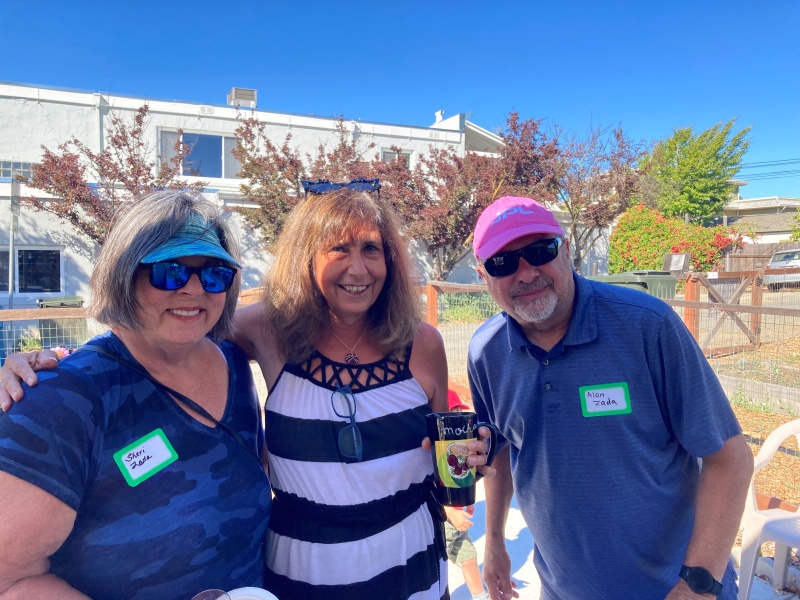
Torchlight Parade BBQ attendees (from left) Sheri Zada, Randi Scott and Alan Zada
Torchlight Parade BBQ
The annual Benicia Torchlight Parade BBQ in Avant Garden on July 3 kicked off the summer gardening season with a fun-filled party enjoyed by garden members and their special guests. Delicious dishes creatively prepared by the Avant and Swenson gardeners were enjoyed along with the usual hamburgers, hot dogs, chicken and vegetarian BBQ fare. Several of the Avant Garden members were cheered as they marched up First Street and some of our own Benicia city officials joined in the festivities at Avant after riding the parade route. As usual, a good time was enjoyed by everyone attending our small-town Benicia Independence Day celebration. Kudos to those garden members who racked up volunteer hours pulling weeds and spreading woodchips, which resulted in Avant looking like the crown jewel of First Street that it has become.
The Share Plot
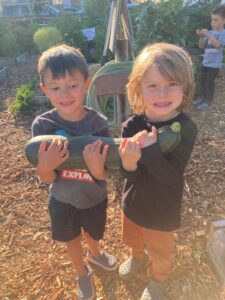
Enzo and Slater hold a 6-pound zucchini at Avant Garden
Monarchs at Avant
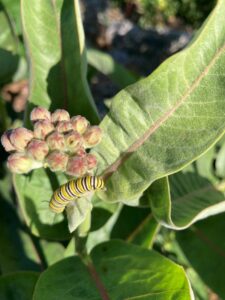
Monarch caterpillars at Avant Garden
Upcoming Garden Events
Stay tuned for upcoming garden events by checking out our calendar. Gardeners are eagerly awaiting their tomato, pepper and cucumber harvests. We are planning a cooking demonstration for August, date TBD. Our Harvest Festival will take place in late September or early October.
Please stop by an enjoy Avant Garden on First and D streets or Swenson Garden at the Heritage Presbyterian Church on the corner of East Second and Military East. Both gardens are serene spaces bursting with fresh vegetables, herbs and flowers. Remember to look but not touch or take. Each of the garden beds are lovingly cared for and owned by individual gardeners who are growing for their personal use.
Happy gardening!
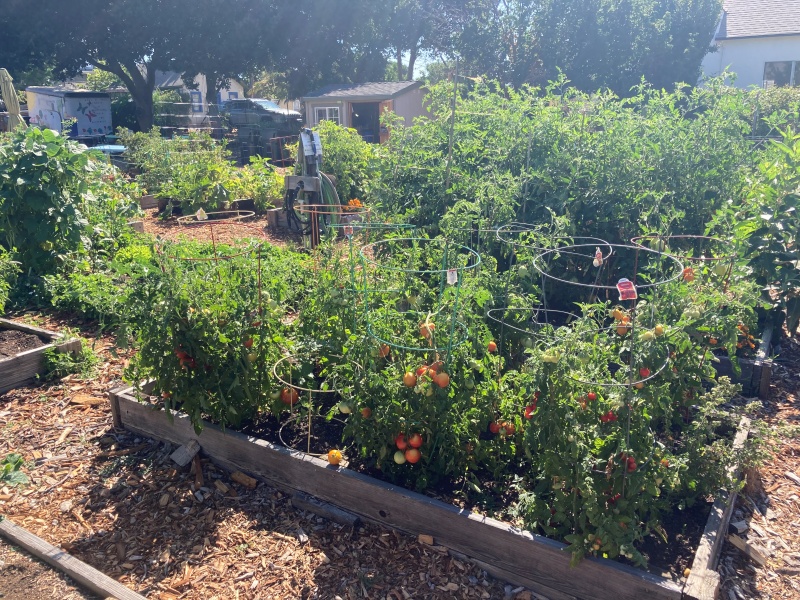

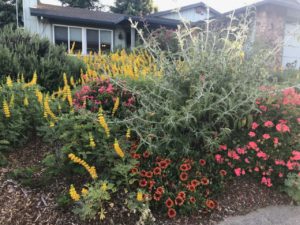 Mature front yard food forest has mostly fruit trees and native plants that attract pollinators year-round. It has a laundry-to-landscape greywater system.
Mature front yard food forest has mostly fruit trees and native plants that attract pollinators year-round. It has a laundry-to-landscape greywater system. An 8-year-old established food forest with two swales that are dug out and refreshed every 2-3 years, laundry-to-landscape greywater to fruit trees, and chickens. The drip irrigation system was removed three years ago and the garden is thriving! Annual beds are hand-watered once a week during the growing season. Greyhawk Grove is a “high-traffic-survival-of-the-fittest-have-three-young-children garden”. There may be lemonade and baked goods for sale by children, as well as products from the garden to give away (dried calendula, lavender, herbs, eggs, fruit, etc.).
An 8-year-old established food forest with two swales that are dug out and refreshed every 2-3 years, laundry-to-landscape greywater to fruit trees, and chickens. The drip irrigation system was removed three years ago and the garden is thriving! Annual beds are hand-watered once a week during the growing season. Greyhawk Grove is a “high-traffic-survival-of-the-fittest-have-three-young-children garden”. There may be lemonade and baked goods for sale by children, as well as products from the garden to give away (dried calendula, lavender, herbs, eggs, fruit, etc.).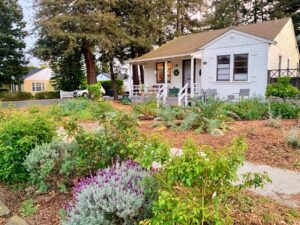 Food forest garden and greywater system installed as part of Sustainable Solano’s 2021
Food forest garden and greywater system installed as part of Sustainable Solano’s 2021 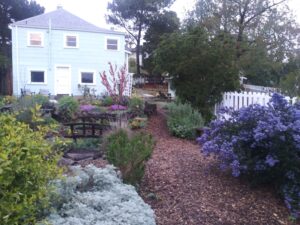 Southern slope food forest focused on pollinators, shrubs and native plants. It also includes fruit trees, perennial and edible plants, swales and a laundry-to-landscape greywater system.
Southern slope food forest focused on pollinators, shrubs and native plants. It also includes fruit trees, perennial and edible plants, swales and a laundry-to-landscape greywater system.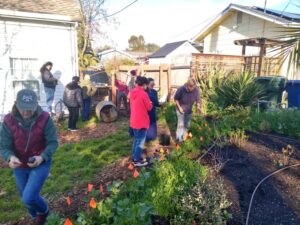 A new and evolving food forest garden and greywater system installed as part of Sustainable Solano’s 2022-23
A new and evolving food forest garden and greywater system installed as part of Sustainable Solano’s 2022-23 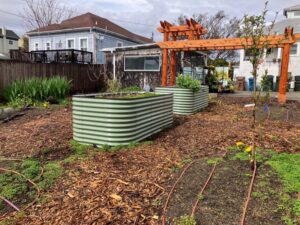 This homeowner attended our tours and was inspired to transform his yard! This brand new garden, designed by Michael Wedgley, is a unique opportunity to tour a stunning and sustainable backyard that showcases the beauty and abundance of permaculture. This eco-conscious backyard features a rainwater catchment system that can harvest up to 3,500 gallons per year, helping to restore the on-site water table, and providing an abundant source of water for this permaculture food forest.
This homeowner attended our tours and was inspired to transform his yard! This brand new garden, designed by Michael Wedgley, is a unique opportunity to tour a stunning and sustainable backyard that showcases the beauty and abundance of permaculture. This eco-conscious backyard features a rainwater catchment system that can harvest up to 3,500 gallons per year, helping to restore the on-site water table, and providing an abundant source of water for this permaculture food forest.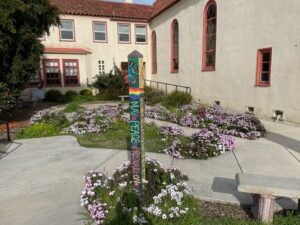 Two separate gardens, one is a peace garden with mostly flowers, cactus and trees and the other is the vegetable garden, called Johnson Ranch. The vegetable garden was revived through the
Two separate gardens, one is a peace garden with mostly flowers, cactus and trees and the other is the vegetable garden, called Johnson Ranch. The vegetable garden was revived through the 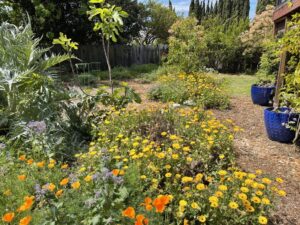 Morningside Botanical Bounty food forest was created as part of the
Morningside Botanical Bounty food forest was created as part of the 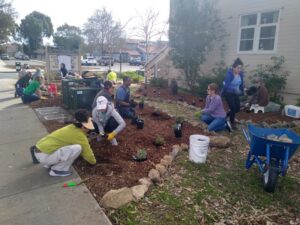 Pollinator food forest garden filled with a variety of California native plants that support the habitat of butterflies, bees, moths, wasps, hummingbirds and so much more. This garden was just installed in February 2023 as a collaboration with a variety of organizations including Vallejo People’s Garden, Vallejo Project, Solano Resource Conservation District and Monarch Milkweed Project. Alanna Mirror wrote three songs inspired by the installation, featured in her
Pollinator food forest garden filled with a variety of California native plants that support the habitat of butterflies, bees, moths, wasps, hummingbirds and so much more. This garden was just installed in February 2023 as a collaboration with a variety of organizations including Vallejo People’s Garden, Vallejo Project, Solano Resource Conservation District and Monarch Milkweed Project. Alanna Mirror wrote three songs inspired by the installation, featured in her 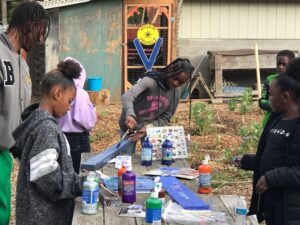 Vallejo Project’s Unity Garden initiative restored an abandoned lot that was once filled with sand and garbage and turned it into a multi-level food forest with internationally influenced farming techniques and 10 chickens. This garden is focused on urban agriculture.
Vallejo Project’s Unity Garden initiative restored an abandoned lot that was once filled with sand and garbage and turned it into a multi-level food forest with internationally influenced farming techniques and 10 chickens. This garden is focused on urban agriculture.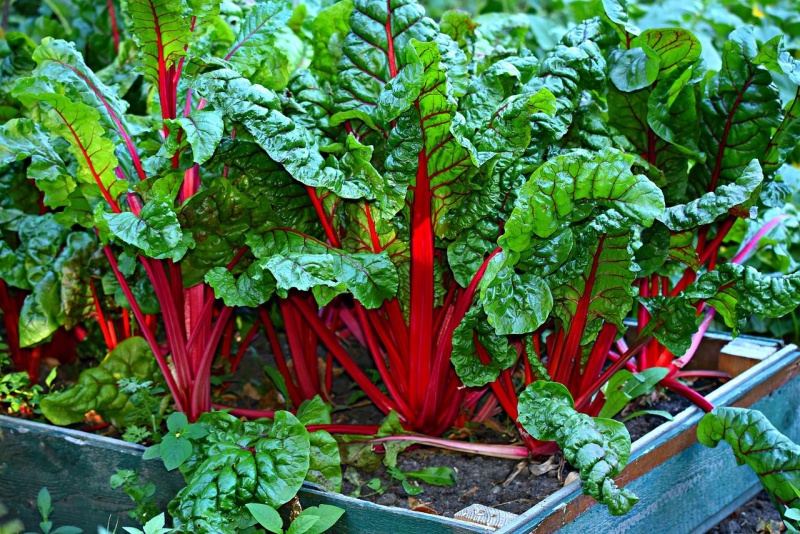
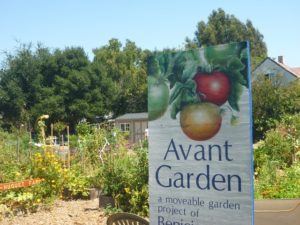 In a lovely British accent, she then proclaimed that what I had just done by giving her the chard was the highlight of her day. “You see, what is happening in Ukraine has brought back so many terrible memories.” With tears in her eyes, she went on to explain that as a child in London she lived through the Nazi bombing known as the Blitz and had spent days underground with her family trying to survive. She was about to celebrate her 89th birthday and she could not believe that she lived to see the horrors of war in Europe again. But the beautiful chard … she would go home and call her family in the UK and tell them what a wonderful gift she had just received. As she parted (yes, I had tears in my eyes now) with her little dog and bag of Swiss chard, I asked her name (Julia) and assured her that any time she saw me in the garden she was welcome to stop by for a chat, chard or any other goodie we might have growing at Avant Garden … and she does! That day, Julia herself was a gift to me. For the last five years that I have been volunteering as garden coordinator, I never know who or what gift will present itself, but I know I will be surprised and grateful.
In a lovely British accent, she then proclaimed that what I had just done by giving her the chard was the highlight of her day. “You see, what is happening in Ukraine has brought back so many terrible memories.” With tears in her eyes, she went on to explain that as a child in London she lived through the Nazi bombing known as the Blitz and had spent days underground with her family trying to survive. She was about to celebrate her 89th birthday and she could not believe that she lived to see the horrors of war in Europe again. But the beautiful chard … she would go home and call her family in the UK and tell them what a wonderful gift she had just received. As she parted (yes, I had tears in my eyes now) with her little dog and bag of Swiss chard, I asked her name (Julia) and assured her that any time she saw me in the garden she was welcome to stop by for a chat, chard or any other goodie we might have growing at Avant Garden … and she does! That day, Julia herself was a gift to me. For the last five years that I have been volunteering as garden coordinator, I never know who or what gift will present itself, but I know I will be surprised and grateful.

